Corporate Accounting for Telstra: Financial Performance, Sources of Finance, and Changes in Accounting Policies
VerifiedAdded on 2023/06/08
|13
|2580
|104
AI Summary
This report provides an overview of Telstra, a leading telecommunication and technology company in Australia, including its financial performance, sources of finance, and changes in accounting policies. The report also covers the industry and competitors of Telstra, as well as its assets, including property, plant, and equipment, and intangibles. The report is based on Telstra's annual report for the financial year 2018.
Contribute Materials
Your contribution can guide someone’s learning journey. Share your
documents today.
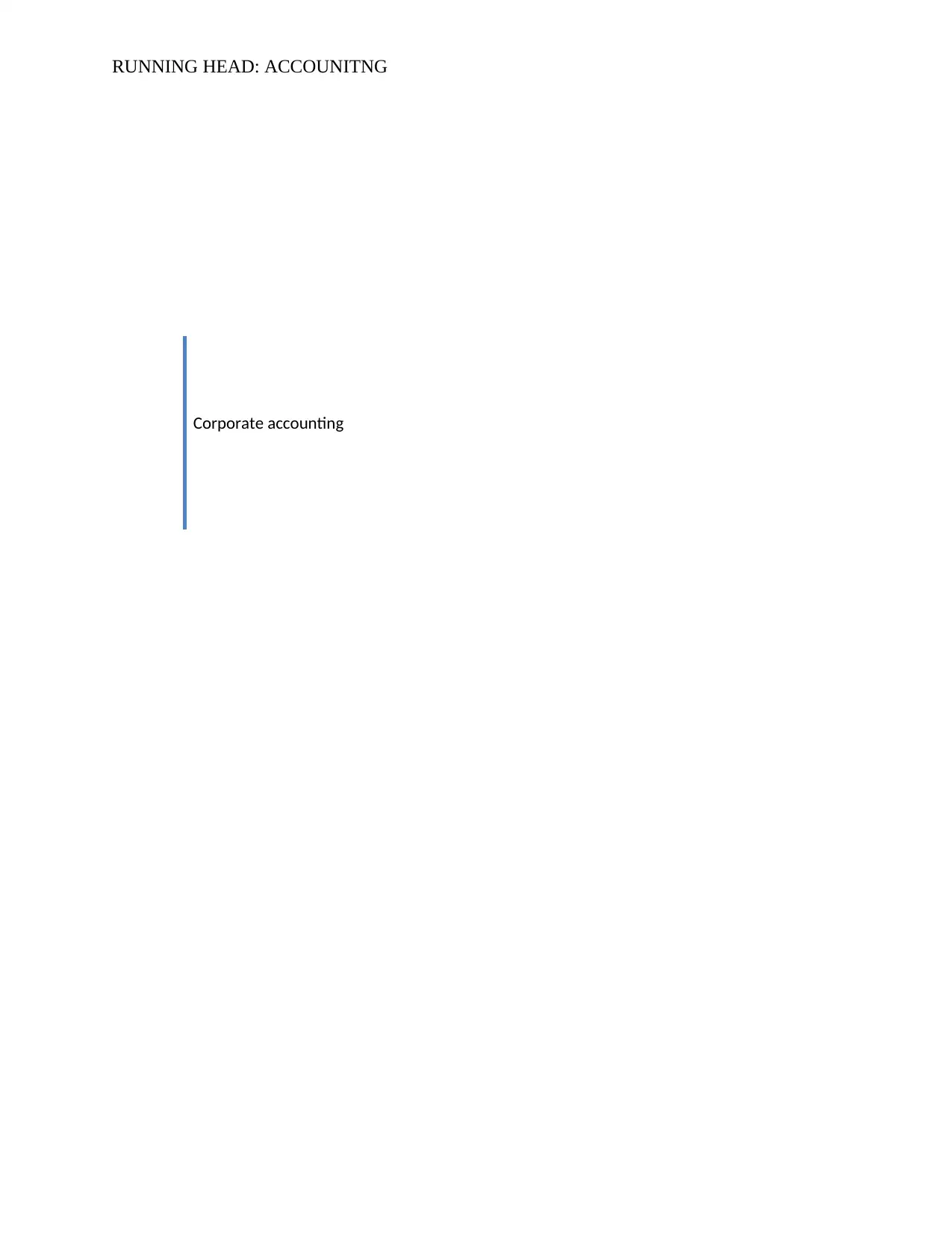
RUNNING HEAD: ACCOUNITNG
Corporate accounting
Corporate accounting
Secure Best Marks with AI Grader
Need help grading? Try our AI Grader for instant feedback on your assignments.
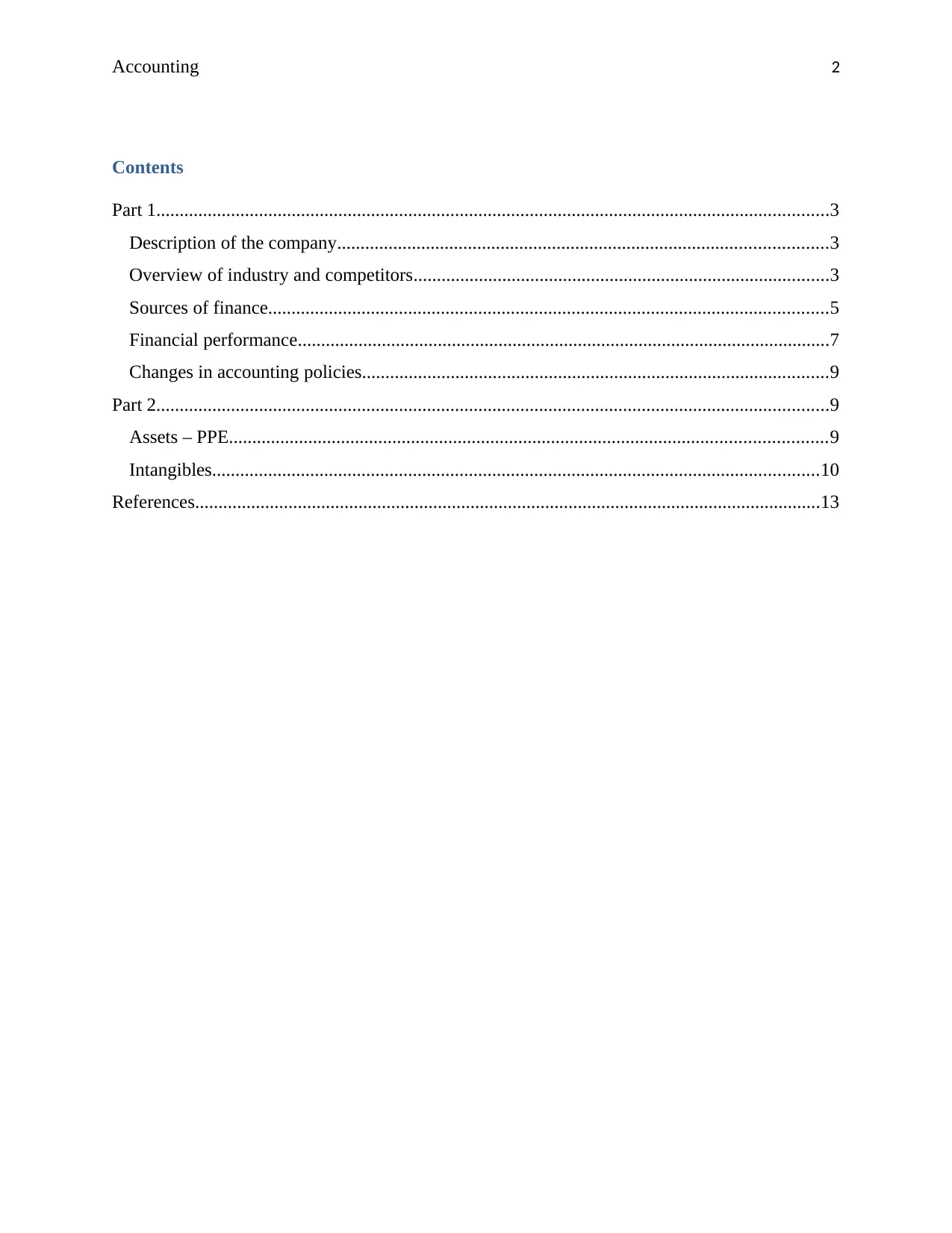
Accounting 2
Contents
Part 1................................................................................................................................................3
Description of the company.........................................................................................................3
Overview of industry and competitors.........................................................................................3
Sources of finance........................................................................................................................5
Financial performance..................................................................................................................7
Changes in accounting policies....................................................................................................9
Part 2................................................................................................................................................9
Assets – PPE................................................................................................................................9
Intangibles..................................................................................................................................10
References......................................................................................................................................13
Contents
Part 1................................................................................................................................................3
Description of the company.........................................................................................................3
Overview of industry and competitors.........................................................................................3
Sources of finance........................................................................................................................5
Financial performance..................................................................................................................7
Changes in accounting policies....................................................................................................9
Part 2................................................................................................................................................9
Assets – PPE................................................................................................................................9
Intangibles..................................................................................................................................10
References......................................................................................................................................13
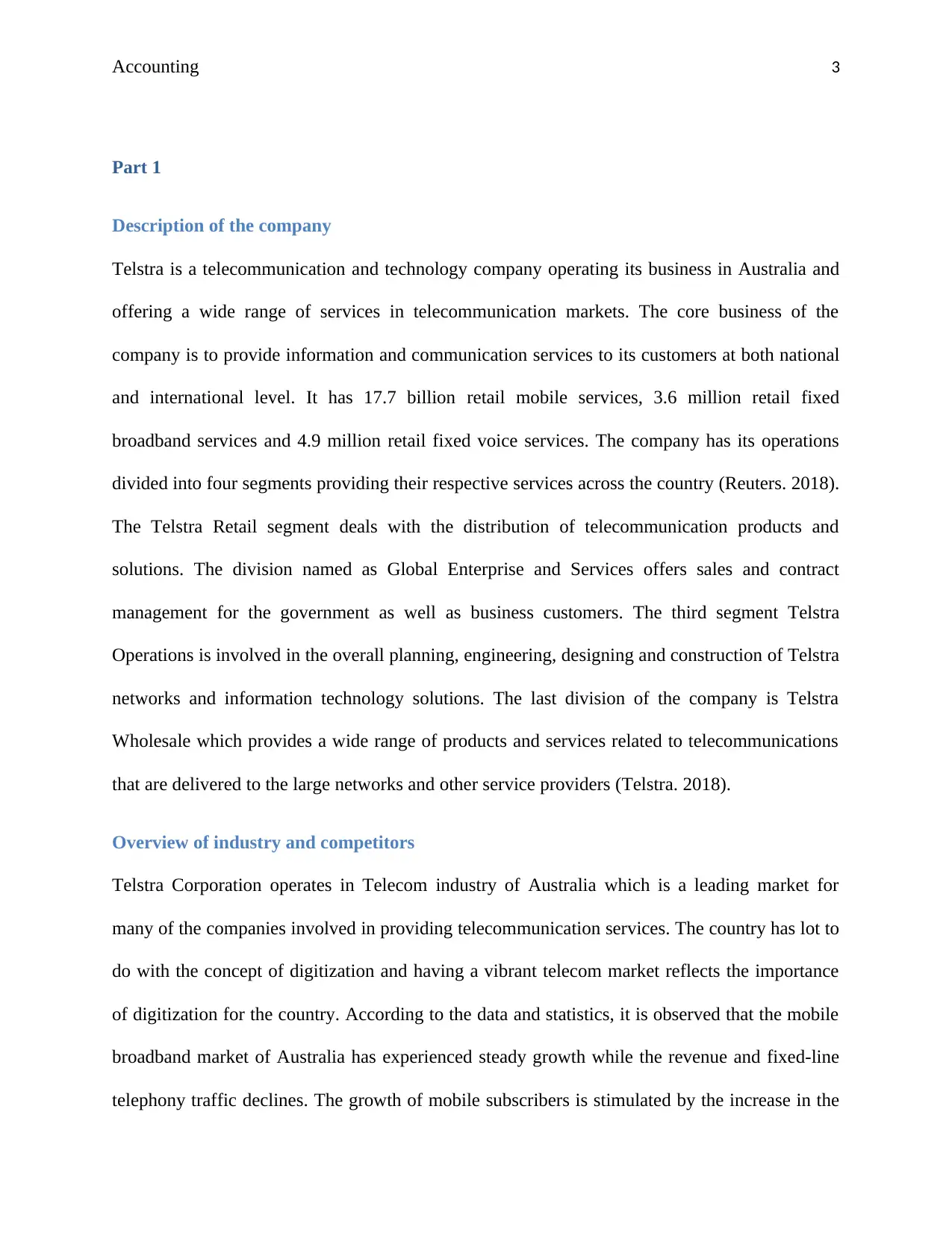
Accounting 3
Part 1
Description of the company
Telstra is a telecommunication and technology company operating its business in Australia and
offering a wide range of services in telecommunication markets. The core business of the
company is to provide information and communication services to its customers at both national
and international level. It has 17.7 billion retail mobile services, 3.6 million retail fixed
broadband services and 4.9 million retail fixed voice services. The company has its operations
divided into four segments providing their respective services across the country (Reuters. 2018).
The Telstra Retail segment deals with the distribution of telecommunication products and
solutions. The division named as Global Enterprise and Services offers sales and contract
management for the government as well as business customers. The third segment Telstra
Operations is involved in the overall planning, engineering, designing and construction of Telstra
networks and information technology solutions. The last division of the company is Telstra
Wholesale which provides a wide range of products and services related to telecommunications
that are delivered to the large networks and other service providers (Telstra. 2018).
Overview of industry and competitors
Telstra Corporation operates in Telecom industry of Australia which is a leading market for
many of the companies involved in providing telecommunication services. The country has lot to
do with the concept of digitization and having a vibrant telecom market reflects the importance
of digitization for the country. According to the data and statistics, it is observed that the mobile
broadband market of Australia has experienced steady growth while the revenue and fixed-line
telephony traffic declines. The growth of mobile subscribers is stimulated by the increase in the
Part 1
Description of the company
Telstra is a telecommunication and technology company operating its business in Australia and
offering a wide range of services in telecommunication markets. The core business of the
company is to provide information and communication services to its customers at both national
and international level. It has 17.7 billion retail mobile services, 3.6 million retail fixed
broadband services and 4.9 million retail fixed voice services. The company has its operations
divided into four segments providing their respective services across the country (Reuters. 2018).
The Telstra Retail segment deals with the distribution of telecommunication products and
solutions. The division named as Global Enterprise and Services offers sales and contract
management for the government as well as business customers. The third segment Telstra
Operations is involved in the overall planning, engineering, designing and construction of Telstra
networks and information technology solutions. The last division of the company is Telstra
Wholesale which provides a wide range of products and services related to telecommunications
that are delivered to the large networks and other service providers (Telstra. 2018).
Overview of industry and competitors
Telstra Corporation operates in Telecom industry of Australia which is a leading market for
many of the companies involved in providing telecommunication services. The country has lot to
do with the concept of digitization and having a vibrant telecom market reflects the importance
of digitization for the country. According to the data and statistics, it is observed that the mobile
broadband market of Australia has experienced steady growth while the revenue and fixed-line
telephony traffic declines. The growth of mobile subscribers is stimulated by the increase in the
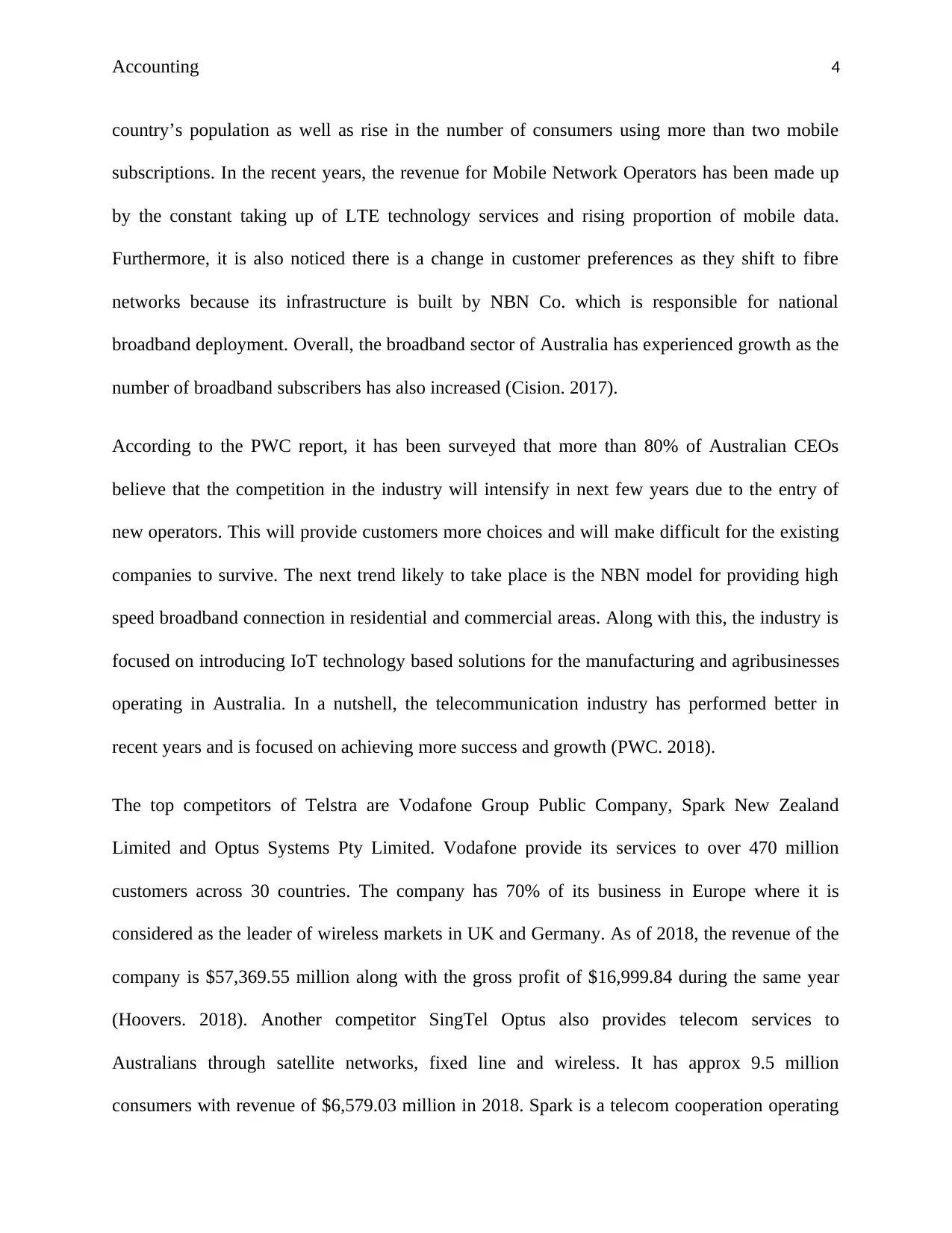
Accounting 4
country’s population as well as rise in the number of consumers using more than two mobile
subscriptions. In the recent years, the revenue for Mobile Network Operators has been made up
by the constant taking up of LTE technology services and rising proportion of mobile data.
Furthermore, it is also noticed there is a change in customer preferences as they shift to fibre
networks because its infrastructure is built by NBN Co. which is responsible for national
broadband deployment. Overall, the broadband sector of Australia has experienced growth as the
number of broadband subscribers has also increased (Cision. 2017).
According to the PWC report, it has been surveyed that more than 80% of Australian CEOs
believe that the competition in the industry will intensify in next few years due to the entry of
new operators. This will provide customers more choices and will make difficult for the existing
companies to survive. The next trend likely to take place is the NBN model for providing high
speed broadband connection in residential and commercial areas. Along with this, the industry is
focused on introducing IoT technology based solutions for the manufacturing and agribusinesses
operating in Australia. In a nutshell, the telecommunication industry has performed better in
recent years and is focused on achieving more success and growth (PWC. 2018).
The top competitors of Telstra are Vodafone Group Public Company, Spark New Zealand
Limited and Optus Systems Pty Limited. Vodafone provide its services to over 470 million
customers across 30 countries. The company has 70% of its business in Europe where it is
considered as the leader of wireless markets in UK and Germany. As of 2018, the revenue of the
company is $57,369.55 million along with the gross profit of $16,999.84 during the same year
(Hoovers. 2018). Another competitor SingTel Optus also provides telecom services to
Australians through satellite networks, fixed line and wireless. It has approx 9.5 million
consumers with revenue of $6,579.03 million in 2018. Spark is a telecom cooperation operating
country’s population as well as rise in the number of consumers using more than two mobile
subscriptions. In the recent years, the revenue for Mobile Network Operators has been made up
by the constant taking up of LTE technology services and rising proportion of mobile data.
Furthermore, it is also noticed there is a change in customer preferences as they shift to fibre
networks because its infrastructure is built by NBN Co. which is responsible for national
broadband deployment. Overall, the broadband sector of Australia has experienced growth as the
number of broadband subscribers has also increased (Cision. 2017).
According to the PWC report, it has been surveyed that more than 80% of Australian CEOs
believe that the competition in the industry will intensify in next few years due to the entry of
new operators. This will provide customers more choices and will make difficult for the existing
companies to survive. The next trend likely to take place is the NBN model for providing high
speed broadband connection in residential and commercial areas. Along with this, the industry is
focused on introducing IoT technology based solutions for the manufacturing and agribusinesses
operating in Australia. In a nutshell, the telecommunication industry has performed better in
recent years and is focused on achieving more success and growth (PWC. 2018).
The top competitors of Telstra are Vodafone Group Public Company, Spark New Zealand
Limited and Optus Systems Pty Limited. Vodafone provide its services to over 470 million
customers across 30 countries. The company has 70% of its business in Europe where it is
considered as the leader of wireless markets in UK and Germany. As of 2018, the revenue of the
company is $57,369.55 million along with the gross profit of $16,999.84 during the same year
(Hoovers. 2018). Another competitor SingTel Optus also provides telecom services to
Australians through satellite networks, fixed line and wireless. It has approx 9.5 million
consumers with revenue of $6,579.03 million in 2018. Spark is a telecom cooperation operating
Secure Best Marks with AI Grader
Need help grading? Try our AI Grader for instant feedback on your assignments.
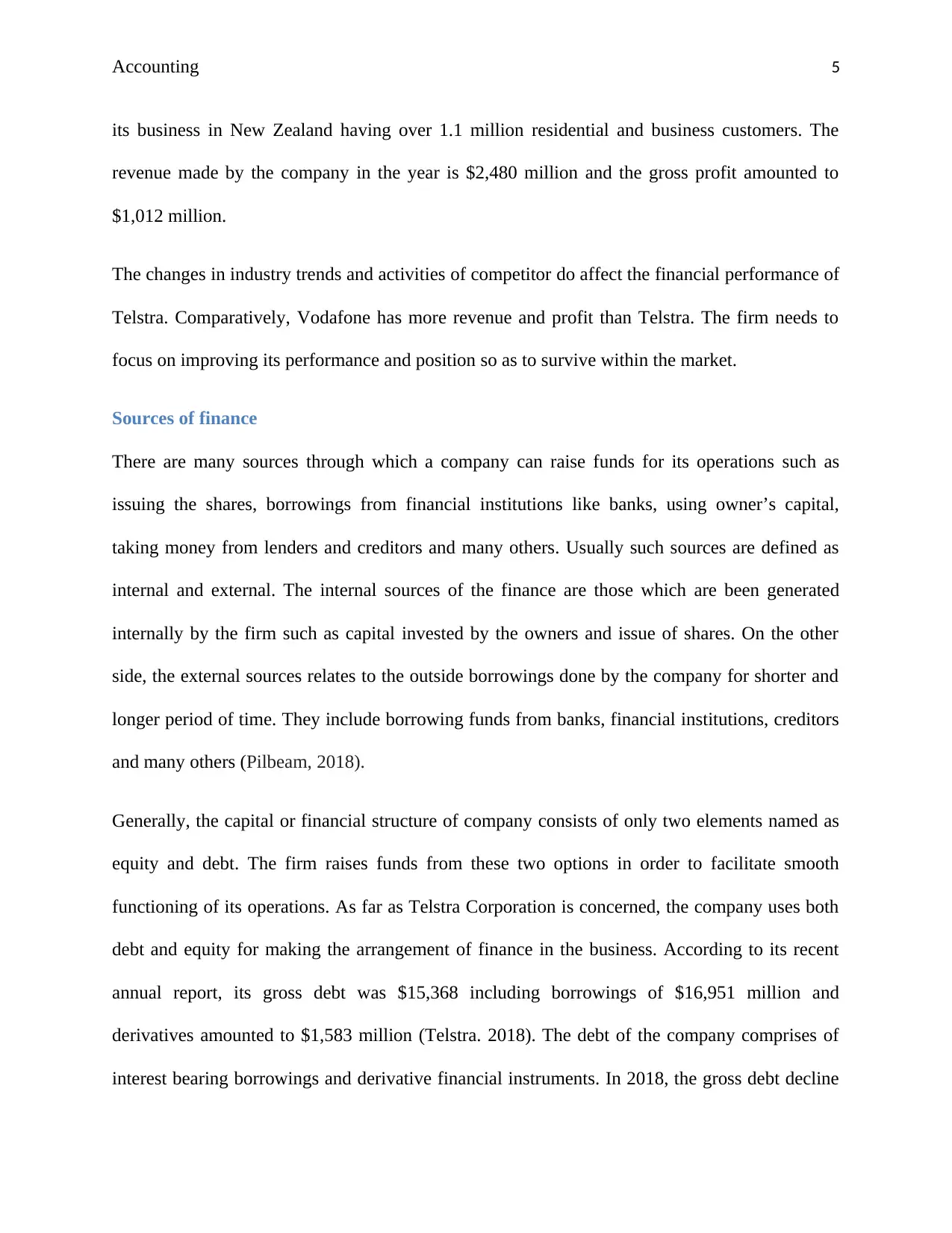
Accounting 5
its business in New Zealand having over 1.1 million residential and business customers. The
revenue made by the company in the year is $2,480 million and the gross profit amounted to
$1,012 million.
The changes in industry trends and activities of competitor do affect the financial performance of
Telstra. Comparatively, Vodafone has more revenue and profit than Telstra. The firm needs to
focus on improving its performance and position so as to survive within the market.
Sources of finance
There are many sources through which a company can raise funds for its operations such as
issuing the shares, borrowings from financial institutions like banks, using owner’s capital,
taking money from lenders and creditors and many others. Usually such sources are defined as
internal and external. The internal sources of the finance are those which are been generated
internally by the firm such as capital invested by the owners and issue of shares. On the other
side, the external sources relates to the outside borrowings done by the company for shorter and
longer period of time. They include borrowing funds from banks, financial institutions, creditors
and many others (Pilbeam, 2018).
Generally, the capital or financial structure of company consists of only two elements named as
equity and debt. The firm raises funds from these two options in order to facilitate smooth
functioning of its operations. As far as Telstra Corporation is concerned, the company uses both
debt and equity for making the arrangement of finance in the business. According to its recent
annual report, its gross debt was $15,368 including borrowings of $16,951 million and
derivatives amounted to $1,583 million (Telstra. 2018). The debt of the company comprises of
interest bearing borrowings and derivative financial instruments. In 2018, the gross debt decline
its business in New Zealand having over 1.1 million residential and business customers. The
revenue made by the company in the year is $2,480 million and the gross profit amounted to
$1,012 million.
The changes in industry trends and activities of competitor do affect the financial performance of
Telstra. Comparatively, Vodafone has more revenue and profit than Telstra. The firm needs to
focus on improving its performance and position so as to survive within the market.
Sources of finance
There are many sources through which a company can raise funds for its operations such as
issuing the shares, borrowings from financial institutions like banks, using owner’s capital,
taking money from lenders and creditors and many others. Usually such sources are defined as
internal and external. The internal sources of the finance are those which are been generated
internally by the firm such as capital invested by the owners and issue of shares. On the other
side, the external sources relates to the outside borrowings done by the company for shorter and
longer period of time. They include borrowing funds from banks, financial institutions, creditors
and many others (Pilbeam, 2018).
Generally, the capital or financial structure of company consists of only two elements named as
equity and debt. The firm raises funds from these two options in order to facilitate smooth
functioning of its operations. As far as Telstra Corporation is concerned, the company uses both
debt and equity for making the arrangement of finance in the business. According to its recent
annual report, its gross debt was $15,368 including borrowings of $16,951 million and
derivatives amounted to $1,583 million (Telstra. 2018). The debt of the company comprises of
interest bearing borrowings and derivative financial instruments. In 2018, the gross debt decline
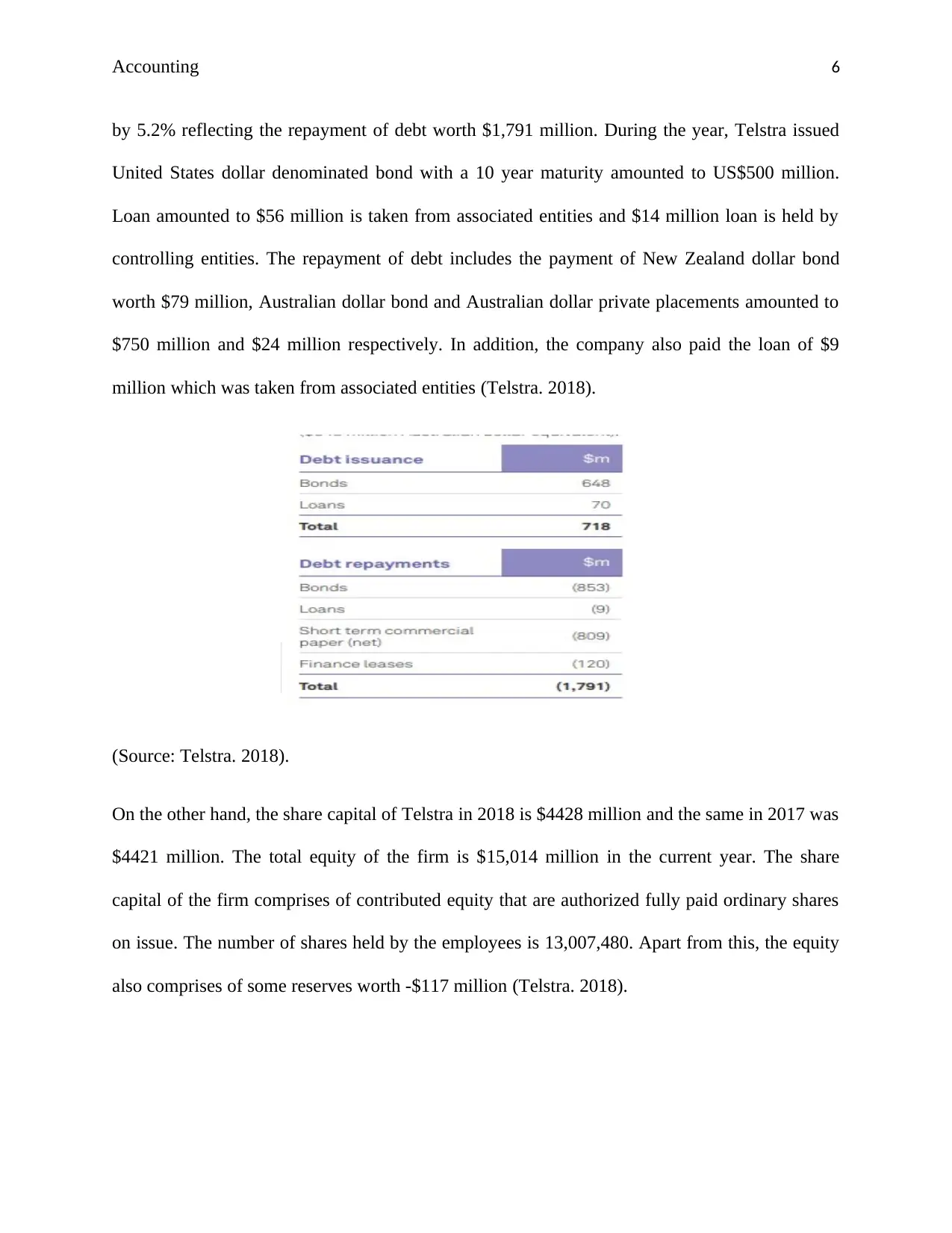
Accounting 6
by 5.2% reflecting the repayment of debt worth $1,791 million. During the year, Telstra issued
United States dollar denominated bond with a 10 year maturity amounted to US$500 million.
Loan amounted to $56 million is taken from associated entities and $14 million loan is held by
controlling entities. The repayment of debt includes the payment of New Zealand dollar bond
worth $79 million, Australian dollar bond and Australian dollar private placements amounted to
$750 million and $24 million respectively. In addition, the company also paid the loan of $9
million which was taken from associated entities (Telstra. 2018).
(Source: Telstra. 2018).
On the other hand, the share capital of Telstra in 2018 is $4428 million and the same in 2017 was
$4421 million. The total equity of the firm is $15,014 million in the current year. The share
capital of the firm comprises of contributed equity that are authorized fully paid ordinary shares
on issue. The number of shares held by the employees is 13,007,480. Apart from this, the equity
also comprises of some reserves worth -$117 million (Telstra. 2018).
by 5.2% reflecting the repayment of debt worth $1,791 million. During the year, Telstra issued
United States dollar denominated bond with a 10 year maturity amounted to US$500 million.
Loan amounted to $56 million is taken from associated entities and $14 million loan is held by
controlling entities. The repayment of debt includes the payment of New Zealand dollar bond
worth $79 million, Australian dollar bond and Australian dollar private placements amounted to
$750 million and $24 million respectively. In addition, the company also paid the loan of $9
million which was taken from associated entities (Telstra. 2018).
(Source: Telstra. 2018).
On the other hand, the share capital of Telstra in 2018 is $4428 million and the same in 2017 was
$4421 million. The total equity of the firm is $15,014 million in the current year. The share
capital of the firm comprises of contributed equity that are authorized fully paid ordinary shares
on issue. The number of shares held by the employees is 13,007,480. Apart from this, the equity
also comprises of some reserves worth -$117 million (Telstra. 2018).
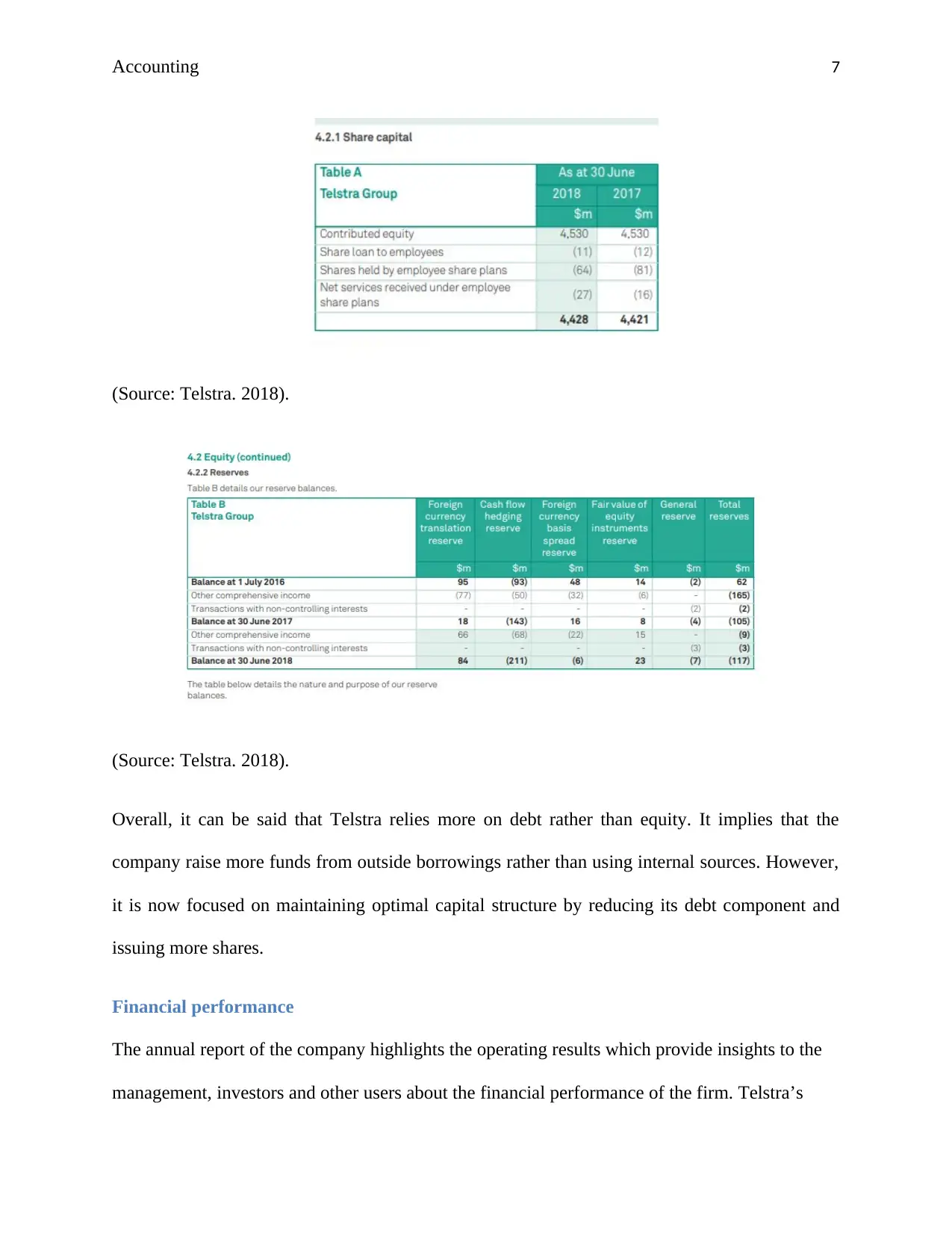
Accounting 7
(Source: Telstra. 2018).
(Source: Telstra. 2018).
Overall, it can be said that Telstra relies more on debt rather than equity. It implies that the
company raise more funds from outside borrowings rather than using internal sources. However,
it is now focused on maintaining optimal capital structure by reducing its debt component and
issuing more shares.
Financial performance
The annual report of the company highlights the operating results which provide insights to the
management, investors and other users about the financial performance of the firm. Telstra’s
(Source: Telstra. 2018).
(Source: Telstra. 2018).
Overall, it can be said that Telstra relies more on debt rather than equity. It implies that the
company raise more funds from outside borrowings rather than using internal sources. However,
it is now focused on maintaining optimal capital structure by reducing its debt component and
issuing more shares.
Financial performance
The annual report of the company highlights the operating results which provide insights to the
management, investors and other users about the financial performance of the firm. Telstra’s
Paraphrase This Document
Need a fresh take? Get an instant paraphrase of this document with our AI Paraphraser

Accounting 8
annual report of financial year 2018 showcases that the company’s total income is up by 3%,
reported at $29.0 billion. However, with the upsurge in income, the net profit after tax reduced
by 8.9% to $3.5 billion. The report also highlighted that the EBITDA of Telstra falls to $10.1
billion reflecting an overall reduction of 5.2%. Talking about the dividends, the company
declared final dividend of 22 cents per share during 2018 (Telstra. 2018).
(Source: Telstra. 2018).
The free cash flow of the firm increased from $3496 million to $4695 million during the year.
Along with this, the capital expenditure has also shown an upward trend and is up by 2.4% at
$4,717 million in the year. Considering the segmental performance, most of the revenue is
generated by Telstra Consumer and Small Business worth $14,683 million. This is followed by
Telstra Wholesale, Telstra Operations and other divisions. The overall finance cost of the
company reduced by 7.1% (Telstra. 2018).
Events occurring after reporting date
As per the report and director’s declaration, there is no circumstance or event that has arisen after
the end of company’s financial year. In their opinion, no such situation has taken place that has
affected the company’s share price and its future performance (Telstra. 2018).
annual report of financial year 2018 showcases that the company’s total income is up by 3%,
reported at $29.0 billion. However, with the upsurge in income, the net profit after tax reduced
by 8.9% to $3.5 billion. The report also highlighted that the EBITDA of Telstra falls to $10.1
billion reflecting an overall reduction of 5.2%. Talking about the dividends, the company
declared final dividend of 22 cents per share during 2018 (Telstra. 2018).
(Source: Telstra. 2018).
The free cash flow of the firm increased from $3496 million to $4695 million during the year.
Along with this, the capital expenditure has also shown an upward trend and is up by 2.4% at
$4,717 million in the year. Considering the segmental performance, most of the revenue is
generated by Telstra Consumer and Small Business worth $14,683 million. This is followed by
Telstra Wholesale, Telstra Operations and other divisions. The overall finance cost of the
company reduced by 7.1% (Telstra. 2018).
Events occurring after reporting date
As per the report and director’s declaration, there is no circumstance or event that has arisen after
the end of company’s financial year. In their opinion, no such situation has taken place that has
affected the company’s share price and its future performance (Telstra. 2018).
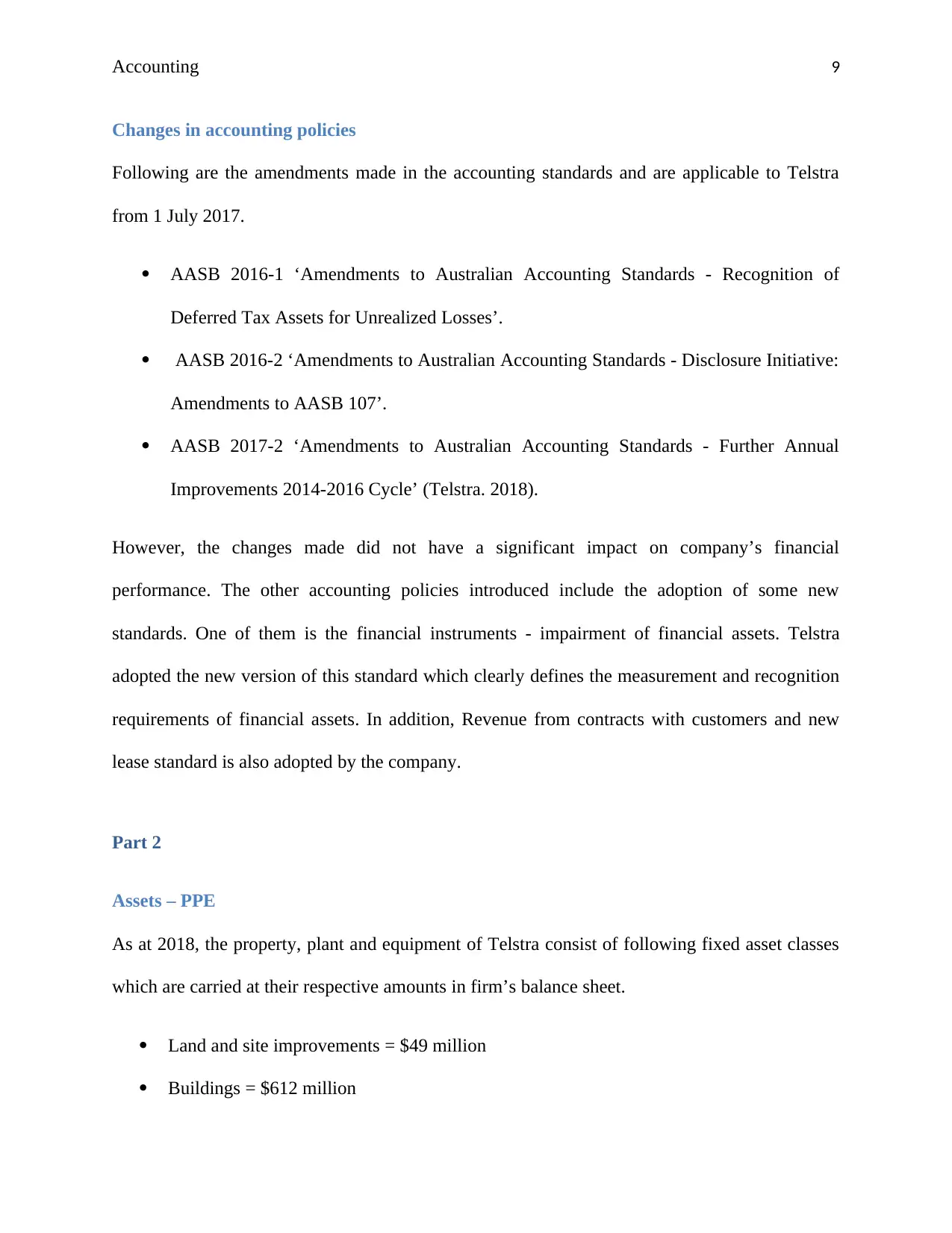
Accounting 9
Changes in accounting policies
Following are the amendments made in the accounting standards and are applicable to Telstra
from 1 July 2017.
AASB 2016-1 ‘Amendments to Australian Accounting Standards - Recognition of
Deferred Tax Assets for Unrealized Losses’.
AASB 2016-2 ‘Amendments to Australian Accounting Standards - Disclosure Initiative:
Amendments to AASB 107’.
AASB 2017-2 ‘Amendments to Australian Accounting Standards - Further Annual
Improvements 2014-2016 Cycle’ (Telstra. 2018).
However, the changes made did not have a significant impact on company’s financial
performance. The other accounting policies introduced include the adoption of some new
standards. One of them is the financial instruments - impairment of financial assets. Telstra
adopted the new version of this standard which clearly defines the measurement and recognition
requirements of financial assets. In addition, Revenue from contracts with customers and new
lease standard is also adopted by the company.
Part 2
Assets – PPE
As at 2018, the property, plant and equipment of Telstra consist of following fixed asset classes
which are carried at their respective amounts in firm’s balance sheet.
Land and site improvements = $49 million
Buildings = $612 million
Changes in accounting policies
Following are the amendments made in the accounting standards and are applicable to Telstra
from 1 July 2017.
AASB 2016-1 ‘Amendments to Australian Accounting Standards - Recognition of
Deferred Tax Assets for Unrealized Losses’.
AASB 2016-2 ‘Amendments to Australian Accounting Standards - Disclosure Initiative:
Amendments to AASB 107’.
AASB 2017-2 ‘Amendments to Australian Accounting Standards - Further Annual
Improvements 2014-2016 Cycle’ (Telstra. 2018).
However, the changes made did not have a significant impact on company’s financial
performance. The other accounting policies introduced include the adoption of some new
standards. One of them is the financial instruments - impairment of financial assets. Telstra
adopted the new version of this standard which clearly defines the measurement and recognition
requirements of financial assets. In addition, Revenue from contracts with customers and new
lease standard is also adopted by the company.
Part 2
Assets – PPE
As at 2018, the property, plant and equipment of Telstra consist of following fixed asset classes
which are carried at their respective amounts in firm’s balance sheet.
Land and site improvements = $49 million
Buildings = $612 million
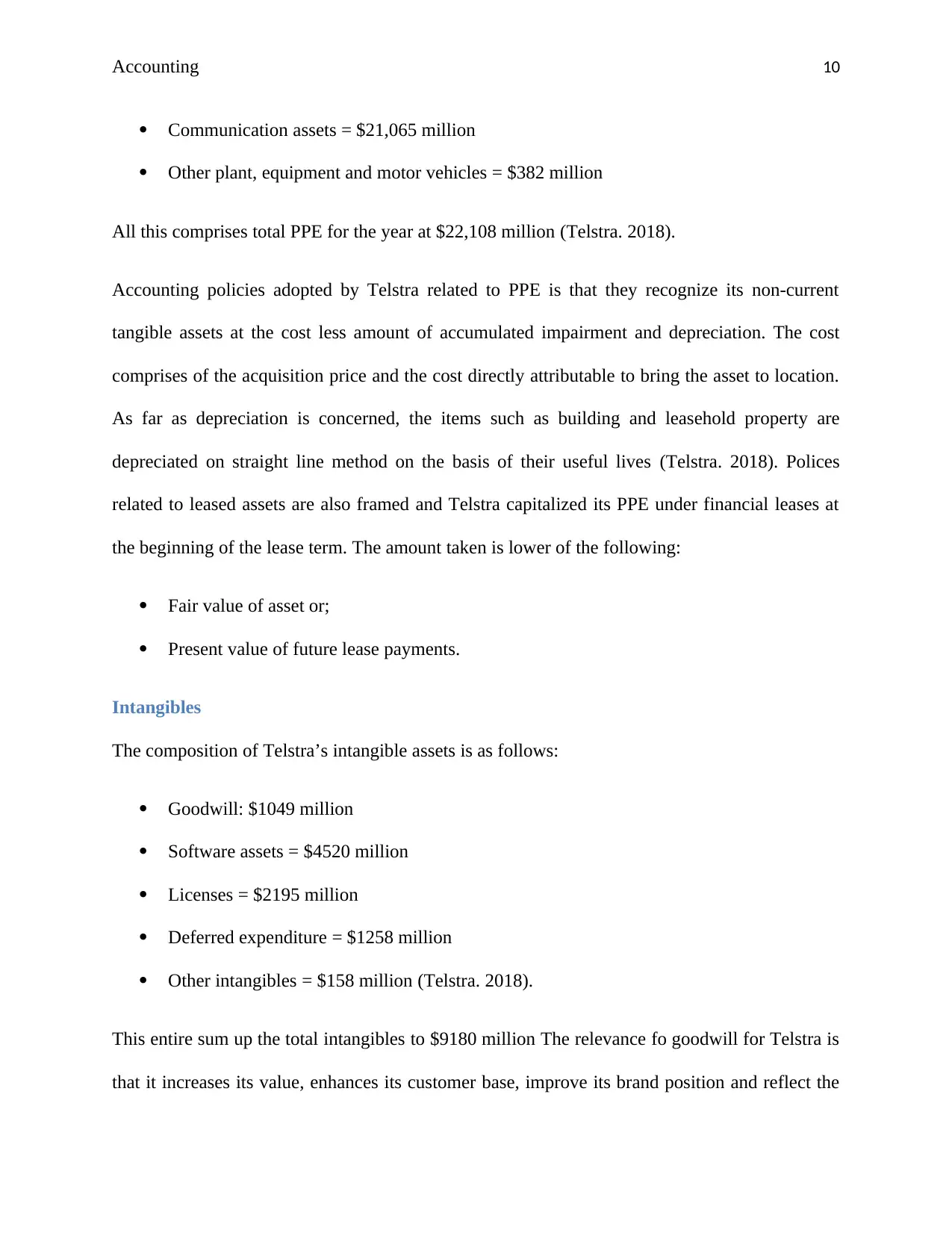
Accounting 10
Communication assets = $21,065 million
Other plant, equipment and motor vehicles = $382 million
All this comprises total PPE for the year at $22,108 million (Telstra. 2018).
Accounting policies adopted by Telstra related to PPE is that they recognize its non-current
tangible assets at the cost less amount of accumulated impairment and depreciation. The cost
comprises of the acquisition price and the cost directly attributable to bring the asset to location.
As far as depreciation is concerned, the items such as building and leasehold property are
depreciated on straight line method on the basis of their useful lives (Telstra. 2018). Polices
related to leased assets are also framed and Telstra capitalized its PPE under financial leases at
the beginning of the lease term. The amount taken is lower of the following:
Fair value of asset or;
Present value of future lease payments.
Intangibles
The composition of Telstra’s intangible assets is as follows:
Goodwill: $1049 million
Software assets = $4520 million
Licenses = $2195 million
Deferred expenditure = $1258 million
Other intangibles = $158 million (Telstra. 2018).
This entire sum up the total intangibles to $9180 million The relevance fo goodwill for Telstra is
that it increases its value, enhances its customer base, improve its brand position and reflect the
Communication assets = $21,065 million
Other plant, equipment and motor vehicles = $382 million
All this comprises total PPE for the year at $22,108 million (Telstra. 2018).
Accounting policies adopted by Telstra related to PPE is that they recognize its non-current
tangible assets at the cost less amount of accumulated impairment and depreciation. The cost
comprises of the acquisition price and the cost directly attributable to bring the asset to location.
As far as depreciation is concerned, the items such as building and leasehold property are
depreciated on straight line method on the basis of their useful lives (Telstra. 2018). Polices
related to leased assets are also framed and Telstra capitalized its PPE under financial leases at
the beginning of the lease term. The amount taken is lower of the following:
Fair value of asset or;
Present value of future lease payments.
Intangibles
The composition of Telstra’s intangible assets is as follows:
Goodwill: $1049 million
Software assets = $4520 million
Licenses = $2195 million
Deferred expenditure = $1258 million
Other intangibles = $158 million (Telstra. 2018).
This entire sum up the total intangibles to $9180 million The relevance fo goodwill for Telstra is
that it increases its value, enhances its customer base, improve its brand position and reflect the
Secure Best Marks with AI Grader
Need help grading? Try our AI Grader for instant feedback on your assignments.
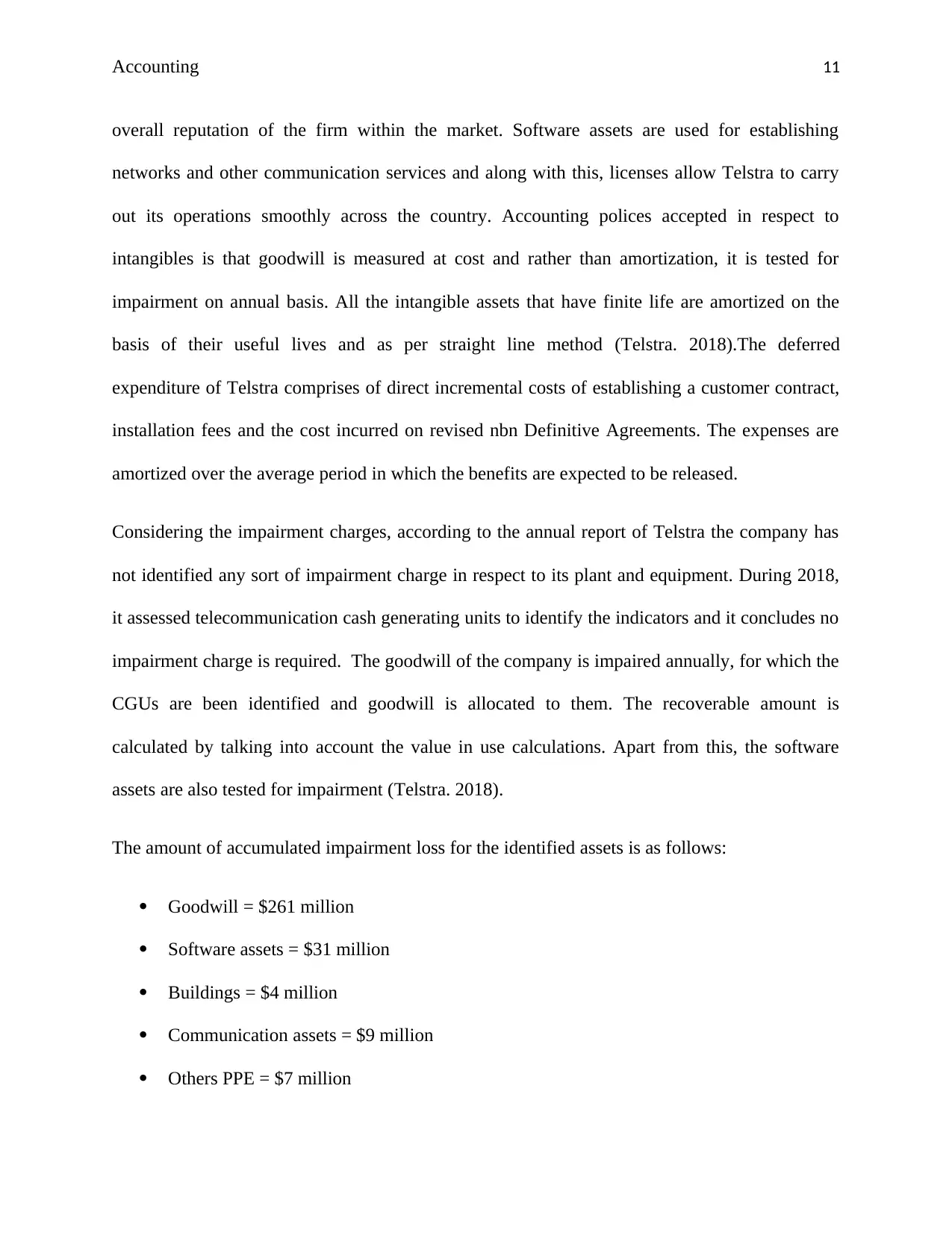
Accounting 11
overall reputation of the firm within the market. Software assets are used for establishing
networks and other communication services and along with this, licenses allow Telstra to carry
out its operations smoothly across the country. Accounting polices accepted in respect to
intangibles is that goodwill is measured at cost and rather than amortization, it is tested for
impairment on annual basis. All the intangible assets that have finite life are amortized on the
basis of their useful lives and as per straight line method (Telstra. 2018).The deferred
expenditure of Telstra comprises of direct incremental costs of establishing a customer contract,
installation fees and the cost incurred on revised nbn Definitive Agreements. The expenses are
amortized over the average period in which the benefits are expected to be released.
Considering the impairment charges, according to the annual report of Telstra the company has
not identified any sort of impairment charge in respect to its plant and equipment. During 2018,
it assessed telecommunication cash generating units to identify the indicators and it concludes no
impairment charge is required. The goodwill of the company is impaired annually, for which the
CGUs are been identified and goodwill is allocated to them. The recoverable amount is
calculated by talking into account the value in use calculations. Apart from this, the software
assets are also tested for impairment (Telstra. 2018).
The amount of accumulated impairment loss for the identified assets is as follows:
Goodwill = $261 million
Software assets = $31 million
Buildings = $4 million
Communication assets = $9 million
Others PPE = $7 million
overall reputation of the firm within the market. Software assets are used for establishing
networks and other communication services and along with this, licenses allow Telstra to carry
out its operations smoothly across the country. Accounting polices accepted in respect to
intangibles is that goodwill is measured at cost and rather than amortization, it is tested for
impairment on annual basis. All the intangible assets that have finite life are amortized on the
basis of their useful lives and as per straight line method (Telstra. 2018).The deferred
expenditure of Telstra comprises of direct incremental costs of establishing a customer contract,
installation fees and the cost incurred on revised nbn Definitive Agreements. The expenses are
amortized over the average period in which the benefits are expected to be released.
Considering the impairment charges, according to the annual report of Telstra the company has
not identified any sort of impairment charge in respect to its plant and equipment. During 2018,
it assessed telecommunication cash generating units to identify the indicators and it concludes no
impairment charge is required. The goodwill of the company is impaired annually, for which the
CGUs are been identified and goodwill is allocated to them. The recoverable amount is
calculated by talking into account the value in use calculations. Apart from this, the software
assets are also tested for impairment (Telstra. 2018).
The amount of accumulated impairment loss for the identified assets is as follows:
Goodwill = $261 million
Software assets = $31 million
Buildings = $4 million
Communication assets = $9 million
Others PPE = $7 million

Accounting 12
Total impairment loss for the company during the year amounted to $568 million (Telstra. 2018).
Total impairment loss for the company during the year amounted to $568 million (Telstra. 2018).
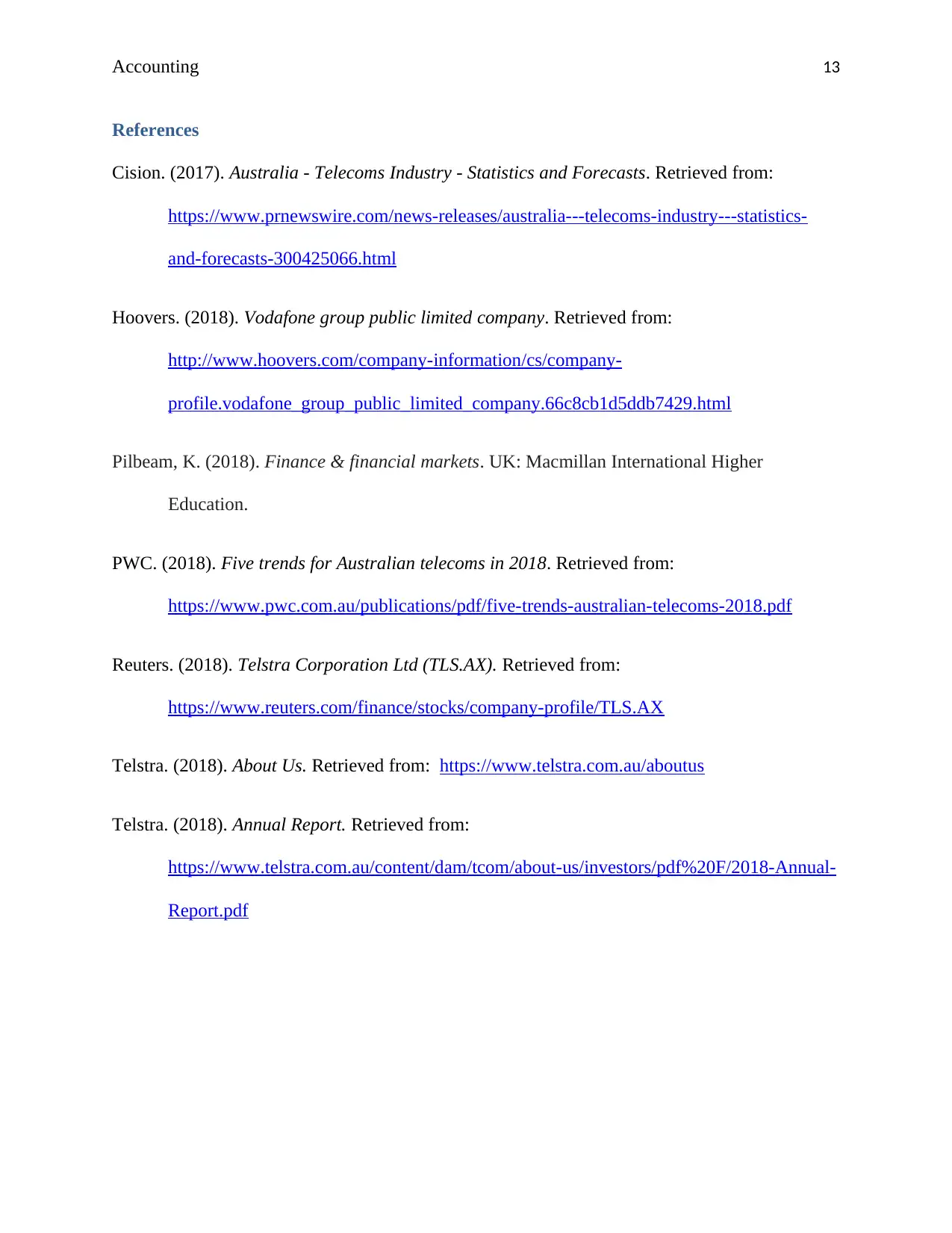
Accounting 13
References
Cision. (2017). Australia - Telecoms Industry - Statistics and Forecasts. Retrieved from:
https://www.prnewswire.com/news-releases/australia---telecoms-industry---statistics-
and-forecasts-300425066.html
Hoovers. (2018). Vodafone group public limited company. Retrieved from:
http://www.hoovers.com/company-information/cs/company-
profile.vodafone_group_public_limited_company.66c8cb1d5ddb7429.html
Pilbeam, K. (2018). Finance & financial markets. UK: Macmillan International Higher
Education.
PWC. (2018). Five trends for Australian telecoms in 2018. Retrieved from:
https://www.pwc.com.au/publications/pdf/five-trends-australian-telecoms-2018.pdf
Reuters. (2018). Telstra Corporation Ltd (TLS.AX). Retrieved from:
https://www.reuters.com/finance/stocks/company-profile/TLS.AX
Telstra. (2018). About Us. Retrieved from: https://www.telstra.com.au/aboutus
Telstra. (2018). Annual Report. Retrieved from:
https://www.telstra.com.au/content/dam/tcom/about-us/investors/pdf%20F/2018-Annual-
Report.pdf
References
Cision. (2017). Australia - Telecoms Industry - Statistics and Forecasts. Retrieved from:
https://www.prnewswire.com/news-releases/australia---telecoms-industry---statistics-
and-forecasts-300425066.html
Hoovers. (2018). Vodafone group public limited company. Retrieved from:
http://www.hoovers.com/company-information/cs/company-
profile.vodafone_group_public_limited_company.66c8cb1d5ddb7429.html
Pilbeam, K. (2018). Finance & financial markets. UK: Macmillan International Higher
Education.
PWC. (2018). Five trends for Australian telecoms in 2018. Retrieved from:
https://www.pwc.com.au/publications/pdf/five-trends-australian-telecoms-2018.pdf
Reuters. (2018). Telstra Corporation Ltd (TLS.AX). Retrieved from:
https://www.reuters.com/finance/stocks/company-profile/TLS.AX
Telstra. (2018). About Us. Retrieved from: https://www.telstra.com.au/aboutus
Telstra. (2018). Annual Report. Retrieved from:
https://www.telstra.com.au/content/dam/tcom/about-us/investors/pdf%20F/2018-Annual-
Report.pdf
1 out of 13
Related Documents
Your All-in-One AI-Powered Toolkit for Academic Success.
+13062052269
info@desklib.com
Available 24*7 on WhatsApp / Email
![[object Object]](/_next/static/media/star-bottom.7253800d.svg)
Unlock your academic potential
© 2024 | Zucol Services PVT LTD | All rights reserved.





